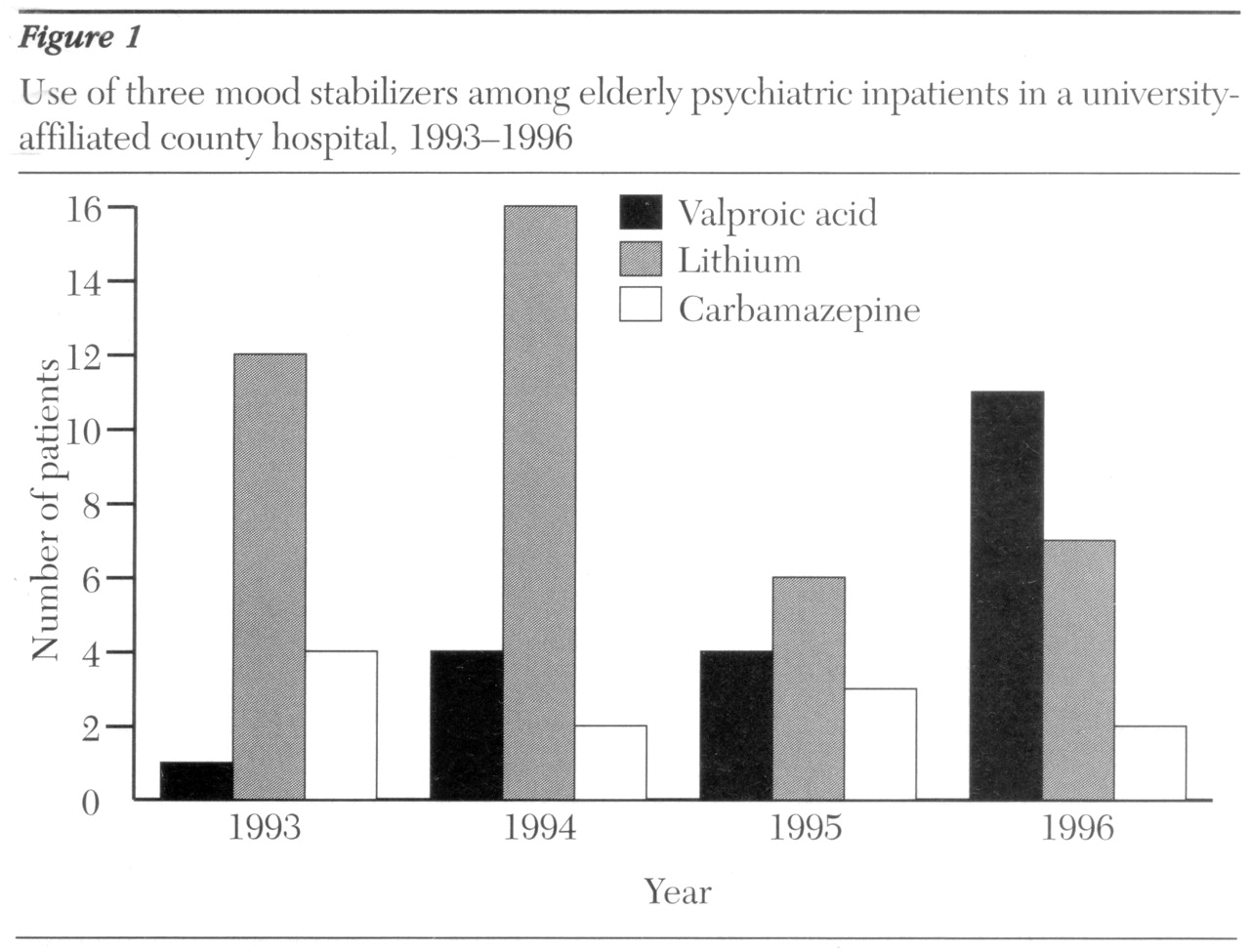Bipolar disorder is a clinically important condition in the geriatric psychiatric population, with reported prevalences ranging from 4 to 19 percent (
1,
2). However, study of bipolar disorder among elderly patients has been limited. A search of MEDLINE for the 20-year period from 1977 to 1997 revealed that the most recent comprehensive review that summarized approaches to pharmacotherapy for elderly patients with bipolar disorder was done by Young (
3) in 1997. The review indicated that minimal research had been conducted on the clinical efficacy of the various mood stabilizers among elderly patients compared with younger patients.
In a five-year retrospective analysis of an adult hospital population irrespective of age (the mean age was about 43 years), Frye and associates (
4) compared the efficacy of the three mood stabilizers—valproic acid, carbamazepine, and lithium—and the combination of them in treatment of patients with classic and dysphoric mania. Length of stay in the hospital was used as the major outcome measure. Some patients who were treated with valproic acid received a high-load dosage of 20 mg per kilogram of body weight. The analysis by Frye and associates indicated that when used alone, valproic acid had significantly better efficacy than either lithium or carbamazepine in helping patients achieve hospital discharge.
Most studies of geriatric populations have examined only lithium treatment for patients with acute mania (
5), despite the findings by Puryear and Kunik (
6) that valproic acid is well tolerated by elderly patients. With the Food and Drug Administration's 1995 approval of valproic acid for use in treatment of bipolar disorder, the need to study its clinical efficacy among elderly patients was apparent. Our study examined the comparative efficacy of selected mood stabilizers among elderly patients. Our hypothesis was that valproic acid would be superior to other agents.
Methods
The study focused on an inpatient geriatric population with bipolar disorder and was modeled after the study by Frye and associates (
4). We did a retrospective chart review at a university-affiliated county hospital in New York State. The charts of psychiatric patients age 60 or older with a discharge diagnosis of bipolar disorder were reviewed for the four-year period from 1993 to 1996. Of 122 charts identified for the study, 72 satisfied all inclusion and exclusion criteria for analysis.
Patients were included if they met DSM-IV criteria for bipolar disorder at admission and were maintained on mood stabilizer monotherapy with lithium, carbamazepine, or valproic acid during hospitalization. If patients had more than one course of monotherapy while hospitalized, the monotherapy that resulted in discharge was used in the analysis of length of treatment. Patients were excluded if their hospital stay was lengthened because of medical illness, if they were not placed on a mood stabilizer, or if they were treated with more than one mood stabilizer simultaneously.
Data gathered from the 72 charts included demographic information such as age, gender, family history of psychiatric illness, number of years with the diagnosis of bipolar disorder, and number of previous psychiatric hospitalizations. Assessment and treatment data included mood stabilizer used, blood levels of the medication at discharge, length of treatment with the mood stabilizer in days, and Global Assessment of Functioning (GAF) score at admission and discharge.
SPSS statistical programs were used for data analysis. Frequency distributions of all variables were obtained, and means with standard deviations were calculated. Using these results, two one-way analyses of variance were done to determine if there were significant differences between the three mood stabilizers in change in GAF scores between admission and discharge and in length of treatment.
Results
The 72 patients whose charts were reviewed for the study included 27 men and 45 women with a mean±SD age of 67.19±5.34 years. Thirty-four patients had a family history of psychiatric illness, but the majority of these patients were unsure if the illness was bipolar disorder. Sixty-two patients had ten or more admissions. The average number of years since patients had received a diagnosis of bipolar disorder was 29.62±10.52.
During the study period, 41 patients were treated with lithium, 20 with valproic acid, and 11 with carbamazepine. As
Figure 1 shows, between 1993 and 1996, there was a ninefold increase in the prescribing of valproic acid as sole mood stabilizer, although the change over the study period for valproic acid was statistically no different than the changes for lithium and carbamazepine. Lithium use declined over this period, while use of carbamazepine maintained essentially the same level. Reasons reported in the charts for the change to valproic acid included patients' refusal of other medications; rapid cycling of bipolar symptoms; side effects of lithium, such as obesity, edema, tremor, and diarrhea; and medical contraindications such as elevated creatinine level and renal failure. A few patients had thyroid abnormalities.
During the study period, valproic acid became a strong alternative to lithium, as indicated by patients' ability to be discharged on this medication. Analysis of data on length of treatment showed that the patients who received carbamazepine were treated for a mean±SD of 27.5±15.4 days, compared with 22.1±11.2 days for the patients who received lithium and 24.8±13.5 days for the patients who received valproic acid.
The mean±SD change in GAF scores during hospitalization was 28.8±11.8 for the patients who received carbamazepine, 29.9±15.8 for the patients who received lithium, and 35.2±10.9 for the patients who received valproic acid. The Levene test for homogeniety of variances was used to determine that the sizes of the three groups were acceptable for comparisons. No significant differences between the patients treated with the three medications were found.
Although a major trend to use valproic acid more frequently in this geriatric sample over the study period is apparent, the use of this medication did not lead to significant changes in length of treatment or GAF outcome measures.
Discussion
Our study did not confirm the finding of Frye and associates (
4) that length of stay was significantly shorter with the use of valproic acid than with the use of lithium alone or carbamazepine alone. Explanations for the difference may include sample size, study type, or the lack of a loading dosage of valproic acid in our sample. The clinicians who treated the elderly patients in our study chose to slowly titrate valproic acid to avoid side effects or toxicity. Although valproic acid is well tolerated by elderly patients (
6), no formal prospective studies solely examining their ability to tolerate loading dosages have been done. Also, in our study, almost all patients discharged on lithium or carbamazepine had therapeutic levels of these drugs. In contrast, Frye and associates acknowledged that many patients in their sample did not have therapeutic blood levels of these drugs. A prospective controlled study of geriatric patients that includes loading dosages of valproic acid would have to be ethically justified but could help clinicians to determine the efficacy of such a practice.
The pharmacokinetic characteristics of lithium and valproic acid, both of which were used more often than carbamazepine in our sample, change depending on the age of the patient. Elderly patients need lower lithium dosages than younger patients to achieve equivalent plasma levels (
7). Reasons for this difference include lithium's reduced clearance and reduced volume of distribution due to the increased fat-to-lean body mass ratio with age. The free fraction of valproic acid can increase with the age of the patient, because elderly persons have a decreased albumin concentration (
8). This change could affect clinical outcome by theoretically increasing the chances of toxicity.
These pharmacokinetic characteristics should be considered in interpreting the outcome measures used in this study because elderly patients' time to reach therapeutic blood levels can be different from that of younger patients, and toxicity could occur more readily among older patients if treatment is initiated too rapidly. Studies that compare elderly and younger patients' tolerance of lithium and valproic acid when treatment is initiated and studies that compare the two groups' relapse rates and blood levels of medication could help further define the differences in these two populations.
Although no geriatric patients with bipolar disorder were found in a community sample surveyed in the Epidemiologic Catchment Area study (
9), the prevalence of this disorder in the psychogeriatric hospital population is high (
1,
2). Further research would help improve the acute, continuing, and maintenance treatment of persons afflicted with bipolar disorder in later life.
Conclusions
Valproic acid is an appropriate alternative to lithium for elderly patients, especially when the use of lithium is contraindicated or shown to be ineffective. Our study shows a large upward trend in the use of valproic acid among elderly patients and suggests that valproic acid is similar to lithium in clinical effectiveness for the treatment of acute bipolar disorder.
Our study showed no significant differences in the outcome measures of acutely ill geriatric patients with bipolar disorder who were treated with lithium, valproic acid, or carbamazepine alone. However, the study was a retrospective analysis with a small sample in which loading doses of valproic acid were not used. We need further research that focuses on the geriatric patient population and on specific treatment issues, such as toleration of the newer treatment practices used with younger patients.


